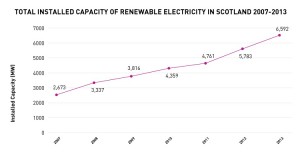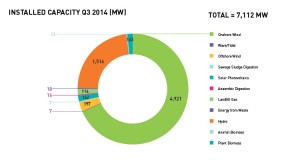I returned recently from a two-week visit to Scotland, my wife’s home country. She and I are now the owners of a flat (apartment in Americanese) in East Kilbride, near Glasgow, that makes visiting with her family much easier. Another exciting feature is that on all clear days (it happens occasionally in Scotland) we can see, from the flat’s bedroom windows, wind turbines spinning in the nearby Whitelee wind farm, currently the largest operating onshore wind farm in Europe (just under 600MWp). The wind farm is several miles away from the flat.
The purpose of this blog post is to discuss the exciting developments taking place in Scotland’s energy system, where the stated national goal is to go 100% renewables for electricity supply by 2020. Achieving this goal, whether in 2020 or sometime in the decade afterwards, will rely heavily on Scotland’s large wind resources, both onshore and offshore. As a sparsely populated country (total population is 5.4 million ) with significant renewable energy resources, Scotland “..is in a unique position to demonstrate how the transition to a low-carbon, widely distributed energy economy may be undertaken.”
What is Scotland’s current energy situation? In Late November 2014 it was announced by the independent trade body Scottish Renewables that “.. with numbers from the first half of 2014, ..renewable energy was Scotland’s largest source of (electrical) power.” Specifically, for the first half of 2014, renewables provided 10.3 TWh of electrical energy, while nuclear power, previously Scotland’s main sources of electricity, provided 7.8 TWh. Coal was third with 5.6 TWh with natural gas at 1.4 TWh.
This increase in renewable generation continues the trend shown in the following chart:
Installed renewable capacity increased to 7,112 MW by the end of the 3d quarter of 2014 – mostly onshore wind and hydro – with another 441 MW of wind capacity (onshore) in construction, 7,720 MW (onshore and offshore) awaiting construction, and 3,765 MW (onshore) in planning. Small amounts of other renewable generation (biomass, landfill gas, hydro) are also in the pipeline.
With wind power already generating enough electricity to supply more than total Scottish household demand, Niall Stuart, Chief Executive of Scottish Renewables, sees much more potential in the future: “Offshore wind and marine energy (wave, tidal, ocean current) are still in the early stages of development but could make a big contribution to our future energy needs if they get the right support from government. That support includes the delivery of grid connections to the islands, home to the UK’s very best wind, wave and tidal sites.”
Scottish enthusiasm for renewables was bolstered by a report issued by WWF Scotland in January (‘Pathways to Power: Scotland’s route to clean, renewable, secure electricity by 2030’) which concluded that, with respect to electricity, a fossil fuel-free Scotland is not only technically feasible but “..could prove a less costly and safer option than pursuing fossil fuel- based development..” that assumes carbon capture and sequestration (CCS) technology will be operating at scale in 2030. With regard to the Scottish government’s stated goal of decarbonizing the electrical sector by 2030, Paul Gardner of DNV GL, lead author of the report, has stated that “There is no technical reason requiring conventional fossil and nuclear generation in Scotland.” In addition, Gina Hanrahan, climate and energy officer at WWF Scotland, explained that “The report shows that not only is a renewable, fossil fuel-free electricity system perfectly feasible in Scotland by 2030, it’s actually the safe bet. Pursuing this pathway would allow Scotland to maintain and build on its position as the UK and Europe’s renewable powerhouse, cut climate emissions (electricity generation accounts for one-third of Scotland’s emissions) and continue to reap the jobs and investment opportunities offered by Scotland’s abundant renewable resources.”
What is Scotland’s natural resource base for renewables? In addition to its existing installed capacity of hydropower (1.3 GW), it is estimated that wind, wave and tide make up more than 80% of Scotland’s renewable energy potential – 36.5GW/wind (onshore and offshore), 7.5 GW/tidal power, 14 GW/wave power. This total, almost 60 GW, is considerable greater than Scotland’s existing electrical generating capacity from all fuel sources of 10.3 GW.
It is interesting to note that Scotland also has significant fossil fuel resources, including 62.4% of the European Union’s proven oil reserves, 12.5% of the EU’s proven natural gas reserves, and 69% of UK coal reserves. Nonetheless, the Scottish Government, as discussed above, has set ambitious goals for renewable energy production. This is likely driven by concern for global climate change and the economic potential for Scotland as a major source of renewable energy.



